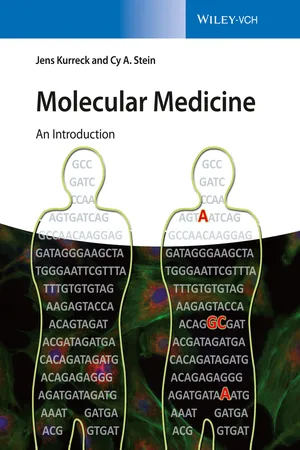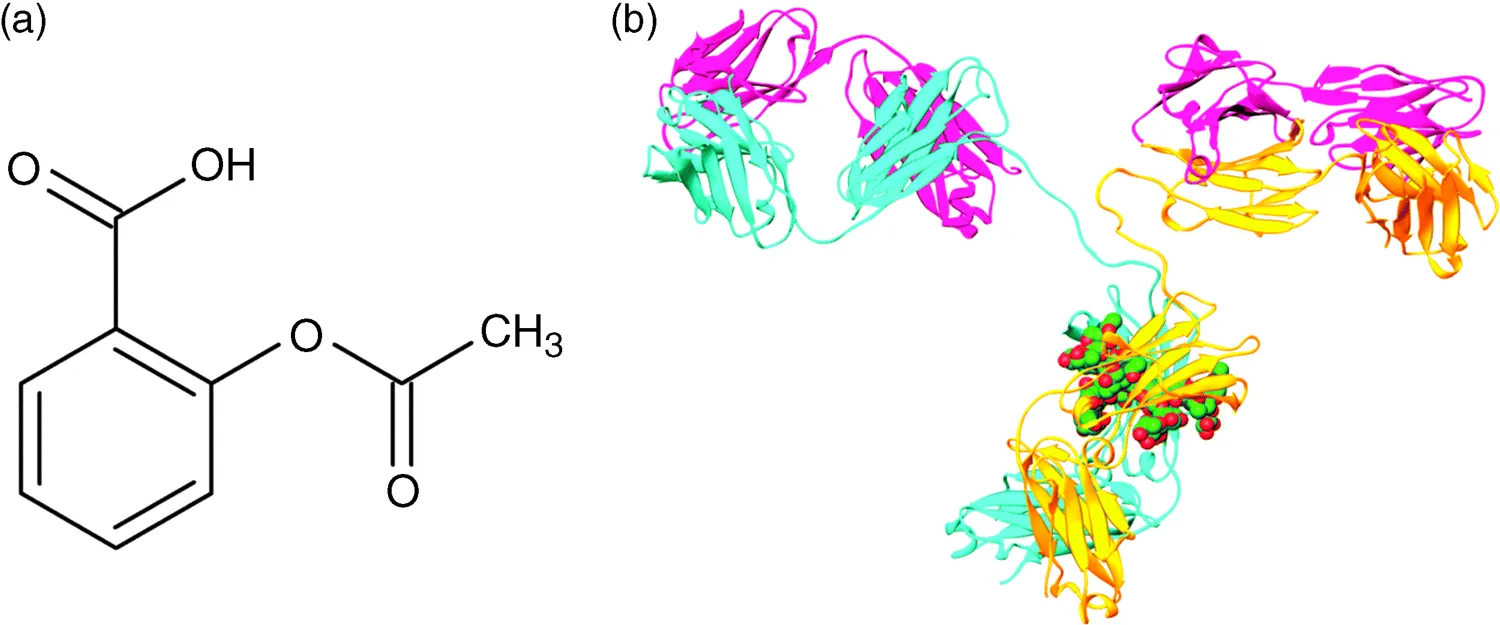
- English
- ePUB (mobile friendly)
- Available on iOS & Android
eBook - ePub
About this book
Easy to read, yet comprehensive, this is the perfect introduction into the molecular basis of disease and the novel treatment options that have become available. The authors, Jens Kurreck and Cy Stein, have both long-standing teaching experience on the subject, one from a biologist's angle, the other with a medical background. Together, they have produced a modern textbook for courses in Molecular Medicine that incorporates modules from immunology to signaling, from virology to gene therapy, and the latest development in personalized medicine.
Frequently asked questions
Yes, you can cancel anytime from the Subscription tab in your account settings on the Perlego website. Your subscription will stay active until the end of your current billing period. Learn how to cancel your subscription.
No, books cannot be downloaded as external files, such as PDFs, for use outside of Perlego. However, you can download books within the Perlego app for offline reading on mobile or tablet. Learn more here.
Perlego offers two plans: Essential and Complete
- Essential is ideal for learners and professionals who enjoy exploring a wide range of subjects. Access the Essential Library with 800,000+ trusted titles and best-sellers across business, personal growth, and the humanities. Includes unlimited reading time and Standard Read Aloud voice.
- Complete: Perfect for advanced learners and researchers needing full, unrestricted access. Unlock 1.4M+ books across hundreds of subjects, including academic and specialized titles. The Complete Plan also includes advanced features like Premium Read Aloud and Research Assistant.
We are an online textbook subscription service, where you can get access to an entire online library for less than the price of a single book per month. With over 1 million books across 1000+ topics, we’ve got you covered! Learn more here.
Look out for the read-aloud symbol on your next book to see if you can listen to it. The read-aloud tool reads text aloud for you, highlighting the text as it is being read. You can pause it, speed it up and slow it down. Learn more here.
Yes! You can use the Perlego app on both iOS or Android devices to read anytime, anywhere — even offline. Perfect for commutes or when you’re on the go.
Please note we cannot support devices running on iOS 13 and Android 7 or earlier. Learn more about using the app.
Please note we cannot support devices running on iOS 13 and Android 7 or earlier. Learn more about using the app.
Yes, you can access Molecular Medicine by Jens Kurreck,Cy Aaron Stein in PDF and/or ePUB format, as well as other popular books in Biological Sciences & Cell Biology. We have over one million books available in our catalogue for you to explore.
Information
1
Introduction
- The Basics of Molecular Medicine
- Topics of Molecular Medicine
- Stages of Drug Development
- The Human Cell
- Organelles
- Cell Cycle
- Apoptosis
- DNA Replication and Gene Expression
- DNA Replication
- Mutations
- Transcription
- Epigenetic Regulation of Gene Expression
- Translation
- Protein Degradation
- Biological Communication
- Neurotransmitters
- Hormones
- Signal Transduction
- The Immune System
- The Innate Immune System
- The Adaptive Immune System
Summary
- Molecular medicine is a highly dynamic field of life science research that uses interdisciplinary approaches to understand normal and pathological cellular processes at the molecular level. The findings of basic research have entered clinical practice, as new diagnostic assays and novel therapeutic strategies focus not only on the symptoms but also on the causes of disease.
- The development of drugs is a long-term and expensive process that starts with basic and preclinical research. A candidate drug must then successfully pass through three types of clinical trial in humans before a novel agent can be approved for therapeutic purposes.
- The eukaryotic cell is compartmentalized into several cellular organelles by intracellular membranes. The nucleus harbors the genetic material, mitochondria are the cellular power plants, and the endoplasmic reticulum and the Golgi apparatus are responsible for the glycosylation and sorting of proteins.
- Cells follow a tightly regulated cycle of four phases. These include the two gap phases G1 and G2, the S phase in which new DNA is synthesized, and mitosis, during which the cell divides.
- Apoptosis is the process of programmed cell death, which is important as a normal physiological mechanism and for protection against infections and cancer. Apoptosis can be triggered by extrinsic or intrinsic signals.
- Genomic DNA is amplified by DNA polymerases in a process known as replication. The synthesis occurs in a semiconservative and semidiscontinuous way.
- Expression of genes requires two steps. In the first step, the DNA is transcribed into RNA. Most primary transcripts are posttranscriptionally processed. For mRNAs, this step includes the addition of a cap at the 5′ end and of a poly(A) tail at the 3′ end. Introns are spliced out to link the exons together. Several bases are modified in various types of RNAs. The second step in gene expression is the translation of the genetic information into proteins. This process is carried out by ribosomes. Posttranslational modifications of proteins include activation by proteolytic cleavage and covalent modification of amino acid side chains. This can occur, for example, by glycosylation or reversible phosphorylation.
- Sophisticated communication between cells is essential for the functioning of a multicellular organism. Neurons transmit signals at synapses. Hormones are molecules that induce physiological responses over a long distance or in adjacent cells. The extracellular signals are transmitted into the cell by cell surface receptors and induce a signaling cascade that leads to a biological response.
- The immune system protects an organism against (infectious) disease. The innate immune response recognizes general patterns of pathogens, while the adaptive immune system is directed against specific targets. The adaptive immune system involves a cellular immune response (T cells) and a humoral immune response (B cells that produce antibodies).
1.1 The Basics of Molecular Medicine
1.1.1 Topics of Molecular Medicine
Molecular medicine is a discipline dedicated to understanding normal and pathological cellular processes at the molecular level. This approach requires the use of many physical, chemical, biological, biochemical, and medical techniques (some of which are introduced in Chapter 2) to understand fundamental molecular mechanisms and how they go awry in disease. Molecular medicine combines classical disciplines such as cell and molecular biology, biochemistry, and medicine. Knowledge is often acquired via interdisciplinary investigation and can be used to develop new forms of molecular diagnosis and therapeutic intervention.
Molecular medicine can be divided into a basic research and an applied clinical discipline. The basic research component investigates molecular and genetic mechanisms of cellular function and identifies pathological processes. In many cases, this addresses a specific question with a hypothesis-driven approach, and can lead to large-scale investigations of whole genomes and proteomes (Chapter 7). The discipline known as translational research then tries to apply the findings from basic science to the clinic, where it may provide new forms of diagnosis and therapy.
A report published by Linus Pauling in 1949 laid the basis for the establishment of the field of molecular medicine. In his seminal paper, he showed that hemoglobin from patients suffering from sickle cell anemia had a different electrical charge than hemoglobin from healthy individuals. This study demonstrated that a disease could be traced to an alteration in the molecular structure of a protein. This novel perspective opened the possibility of establishing novel forms of diagnosis and therapy at the molecular level. Sickle cell anemia is not the only case in which a detailed understanding of the molecular etiology of the disease (e.g., of inherited genetic disorders, Chapter 3) has led to new diagnostic options (Chapter 8), although with only a modestly improved therapeutic outcome.
The field of oncology also illustrates the paradigm shift caused by a molecular perspective. While cancer treatment is still largely based on removal of the tumor by surgery (followed by chemotherapy and/or radiation therapy), molecular oncology (Chapter 4) tries to elucidate those pathways that lead to cellular transformation. This knowledge helps to produce a comprehensive molecular diagnosis of the disease basis in a single patient so that the treatment can be adjusted accordingly, an approach that has come to be known as “personalized medicine.” Many modern anticancer drugs block specific pathways that lead to uncontrolled cellular proliferation. Similarly, elucidation of the life cycles of pathogens has helped develop new drugs for the treatment of infectious diseases (Chapters 5 and 6). For example, advancements in virus biology have led to the identification of novel targets for antiviral agents.
Most drugs belong to the class of small molecular compounds. To achieve oral bioavailability and to promote rapid diffusion across cell membranes and intracellular trafficking to their sites of action, the majority of (oral) drugs have molecular weights below 550 Da (although some antibacterial agents fall in the 700–900 Da range). A prominent example is acetylsalicylic acid (trade name Aspirin, Figure 1.1a), a drug mainly used as an analgesic.

Fig. 1.1 Small molecular drugs and biologics. (a) The chemical structures of acetylsalicylic acid (Aspirin) and (b) the crystal structure of an antibody, shown for comparison. The two structures are not drawn to scale. (Part (b) adapted from Ref. [1] with kind permission from John Wiley & Sons, Inc.)
Molecular medicine has broadened the spectrum of entities used as drugs. New medications are now often based on ...
Table of contents
- Cover
- Related Titles
- Title Page
- Copyright
- Dedication
- Preface
- Chapter 1: Introduction
- Chapter 2: Methods in Molecular Medicine
- Chapter 3: Genetic Disorders
- Chapter 4: Molecular Oncology
- Chapter 5: Molecular Virology
- Chapter 6: Bacteria and Eukaryotic Pathogens
- Chapter 7: Genomics and Proteomics
- Chapter 8: Genetic Testing
- Chapter 9: Pharmacogenetics/Pharmacogenomics
- Chapter 10: Recombinant Protein Drugs
- Chapter 11: Gene Therapy
- Chapter 12: Stem Cells
- Chapter 13: Antisense, Ribozyme, and RNA Interference Strategies
- Chapter 14: Aptamers
- Chapter 15: Ethics in Molecular Medicine
- Abbreviations
- Glossary
- Index
- End User License Agreement